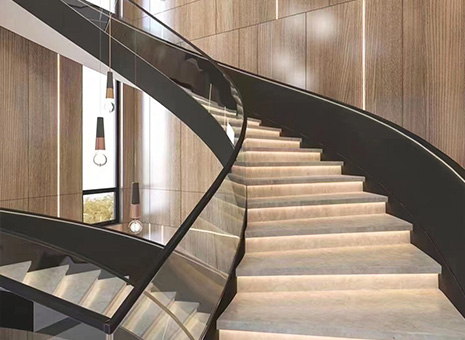Time:2025-08-15 Views:0
Stair railings are essential components of any staircase, providing safety and support for users. A straight stair railing, in particular, is a type of railing that runs parallel to the stairs without any curves or bends. This design is not only aesthetically pleasing but also practical for many residential and commercial settings. In this article, we will delve into the design, installation, and maintenance of straight stair railings, providing a comprehensive guide for homeowners, builders, and architects.
Design Considerations for Straight Stair Railings
When designing a straight stair railing, several factors must be taken into account to ensure both functionality and aesthetic appeal. The following are some key considerations:
1. Material Selection: The choice of material for the railing is crucial. Common materials include wood, metal, glass, and composite materials. Each has its own advantages and disadvantages. For example, wood offers a warm, natural look but requires regular maintenance, while metal provides durability and a modern aesthetic.
2. Height and Spacing: The height of the railing and the spacing between balusters (the vertical supports) must comply with local building codes. Typically, the railing should be between 34 and 38 inches high, and the spacing between balusters should not exceed 4 inches to prevent children from slipping through.
3. Style and Finish: The style and finish of the railing should complement the overall design of the space. Options range from traditional to contemporary, with various finishes such as painted, stained, or polished.
4. Safety Features: Consider adding safety features such as non-slip coatings, rounded edges, and secure fastenings to prevent accidents.
5. Customization: Customizing the railing to fit the specific dimensions and design of the staircase can enhance both its appearance and functionality. This may involve custom-cutting materials or adding decorative elements.

Installation Process for Straight Stair Railings
Installing a straight stair railing requires careful planning and execution to ensure it is secure and meets all safety standards. Here is a step-by-step guide to the installation process:
1. Preparation: Begin by measuring the length of the staircase and determining the number and placement of balusters. Gather all necessary tools and materials, including a level, drill, screws, and the chosen railing components.
2. Marking the Posts: Mark the positions of the newel posts (the vertical posts at the beginning and end of the railing) on the staircase. Ensure they are level and evenly spaced.
3. Attaching the Posts: Secure the newel posts to the staircase using screws or bolts. Make sure they are firmly attached and level.
4. Installing the Handrail: Measure and cut the handrail to the appropriate length. Attach it to the newel posts using brackets or fasteners. Use a level to ensure the handrail is straight and even.
5. Adding Balusters: Install the balusters between the handrail and the staircase. Space them according to building codes and secure them with screws or nails.
6. Finishing Touches: Sand any rough edges, apply the desired finish (such as paint or stain), and add any decorative elements. Ensure all connections are tight and secure.
7. Inspection: Once the railing is installed, inspect it thoroughly to ensure it meets all safety standards and is securely fastened. Test the railing by applying pressure to ensure it does not wobble or come loose.
Maintenance Tips for Straight Stair Railings
Proper maintenance is essential to ensure the longevity and safety of a straight stair railing. Here are some tips for maintaining your railing:
1. Regular Cleaning: Clean the railing regularly to remove dust, dirt, and grime. Use a soft cloth and mild detergent for wood or metal railings. For glass railings, use a glass cleaner and a lint-free cloth.
2. Inspect for Damage: Regularly inspect the railing for signs of wear and tear, such as loose screws, cracks, or splinters. Address any issues promptly to prevent further damage.
3. Re-staining or Painting: Depending on the material, you may need to re-stain or paint the railing periodically to maintain its appearance and protect it from the elements. Follow the manufacturer's recommendations for the frequency and type of finish to use.
4. Lubricating Moving Parts: If your railing has any moving parts, such as adjustable brackets, lubricate them regularly with a suitable lubricant to ensure smooth operation.
5. Replacing Worn Components: Replace any worn or damaged components, such as balusters or fasteners, to maintain the integrity of the railing. Use the same type and quality of materials to ensure a seamless repair.
6. Preventing Water Damage: If your railing is exposed to moisture, take steps to prevent water damage. This may involve applying a water-resistant sealant or ensuring proper drainage around the base of the railing.
7. Professional Inspections: Consider having a professional inspect your railing annually to identify any potential issues and ensure it meets all safety standards.
Conclusion
A straight stair railing is a functional and attractive addition to any staircase, providing safety and support for users. By carefully considering the design, following proper installation techniques, and maintaining the railing regularly, you can ensure it remains a reliable and stylish feature of your home or building for years to come. Whether you choose wood, metal, glass, or another material, a well-designed and well-maintained straight stair railing can enhance the overall aesthetic and functionality of your space.